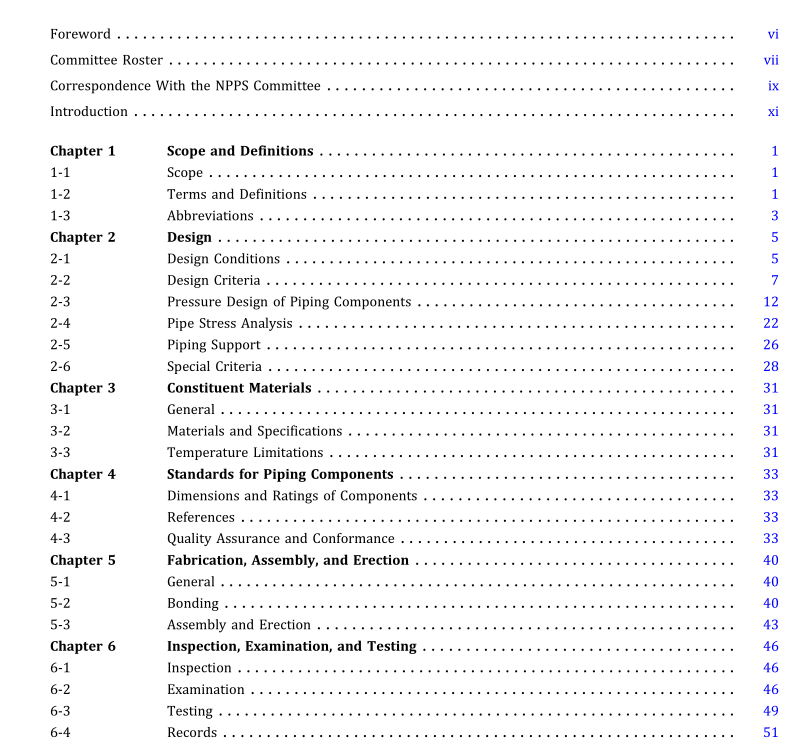ASME NM.2:2018 pdf free download Glass-Fiber-Reinforced Thermosetting-Resin Piping Systems ASME Standards for Nonmetallic Pressure Piping Systems
1-1 scOPE
(a) This Standard provides requirements for thedesign,materials,manufacture, fabrication, installation,examination, and testing of glass-fiber-reinforced thermo-setting-resin (FRP) piping systems.
(b) FRP piping, as used in this Standard , includes pipe,flanges, bolting. gaskets, valves, fittings, special connect-ing components,and the pressure-containing or pressure-retaining portions of other piping components, whethermanufactured in accordance with references cited in thisStandard or specially designed. It also includes hangersand supports and other items necessary to prevent over-stressing the pressure-containing components.
1-1.1 Content and Coverage
(a) This Standard addresses pipe and piping compo-nents that are produced as standard products, as wellas custom products that are designed for a specific appli-cation. It covers FRP pipe and piping components manu-factured by contact molding. centrifugal casting, filamentwinding, and other methods. lts intent is to provide auniform set of requirements for FRP pipe and pipingcomponents that can be adopted by reference in thevarious piping codes,including sections of the ASMEB31 Code for Pressure Piping. This Standard is publishedas a separate document to reduce duplication betweenpiping codes.
(b) Requirements of this Standard apply to FRP pipingsystems typically used within the scope of the varioussections of the ASME B31 Code for Pressure Piping(ASME B31.1,ASME B31.3,ASME B31.4,ASME B31.5,ASME B31.8, and ASME B31.9) and selected pipingsystems designed to the ASME Boiler and PressureVessel Code ( BPVc), Section l1l, Division 1,Subsection ND.
1-1.2 Exclusions
This Standard does not provide requirements for thefollowing:
(a) metallic pipe
(b) thermoplastics,ceramics,and other nonmetallicmaterials used to fabricate pipe and piping components
(c) dual laminate construction that combines thermo-plastic linings with FRP pipe and fittings
(d) reinforced polymer mortar pipe
(e) products with fiber-reinforcement materials thatare not made from glass
nonmetallic pressure vessels, valves, and specialtycomponents covered by other ASME codes and standards,such as ASME BPVC, Section x and ASME RTP-1
(g) piping for which the maximum internal pressureexceeds 1700 kPa(250 psi)
(h) piping for which the algebraic product of internalpressure [in kilopascals gauge (pounds per square inchgauge)] and internal diameter [in meters (inches)]exceeds 1262 kPag-m (7,200 psig-in.)
piping used as ductwork conveying air or othergases at pressures within 6.89 kPag ( 1 psig) of the pres-sure of the surrounding atmosphere
1-2 TERMS AND DEFINITIONS
Commonly used terms relating to FRP piping aredefined below.Some terms are defined with specificrefer-ence to piping. The definitions generally agree with thosein ASME BPVC, Section x; ASME RTP-1; ASTM D883; andASTM F412.Definitions taken unchanged from other stan-dards are indicated by a footnote.
adhesive: a material designed to join together two othercomponent materials by surface attachment (bonding).adhesive joint: a bonded joint made using an adhesive onthe surfaces to be joined.
binder: in a reinforced plastic, the continuous phase thatholds together the reinforcement.
bloom’: a visible exudation or efflorescence on the surfaceof a material.
bonder2: one who performs a manual or semiautomaticbonding operation.
bonding procedure2: the detailed methods and practicesinvolved in the production of a bonded joint.
Bonding Procedure Specification(BPS): a documentproviding in detail the required variables and proceduresfor the bonding process to ensure repeatability in thebonding procedure.
butt-and-wrapped joint: a bonded joint made by applyingplies of reinforcement saturated with resin to the surfacesto be joined.
chalking’ : (plastics) a powdery residue on the surface of amaterial resulting from degradation or migration of aningredient, or both.
chopped roving: a collection of noncontinuous glassstrands gathered without mechanical twist. Eachstrand is made up of glass filaments bonded togetherwith a finish or size for application by chopper gun.chopped-strand mat: reinforcement made from randomlyoriented glass strands that are held together in mat formusing a binder. Each strand has a sizing.
composite’: a solid product consisting of two or moredistinct phases,including a binding material (matrix)and a particulate or fibrous reinforcement material.continuous roving: a collection of continuous glass strandswound into a cylindrical package without mechanicaltwist.
corrosion barrier: a resin-rich internal or external layerthat inhibits penetration of corrosive chemicals to thestructural layers of the laminate.This layer is typicallyreinforced with a glass or synthetic veil and one ormore layers of chopped-strand mat.
creep: the time-dependent part of strain resulting fromstress.
cure: to change the properties of a polymeric system into amore stable, usable condition by the use of heat, radiation,or reaction with chemical additives.
cure time: the period of time that a reacting thermosettingmaterial is exposed to specific conditions to reach a speci-fied property level.
curing agent: a reactive material that when combined witha resin material initiates polymerization or reacts with aresin to polymerize the resin; also referred to as a hard-ener.
ASME NM.2:2018 pdf free download
